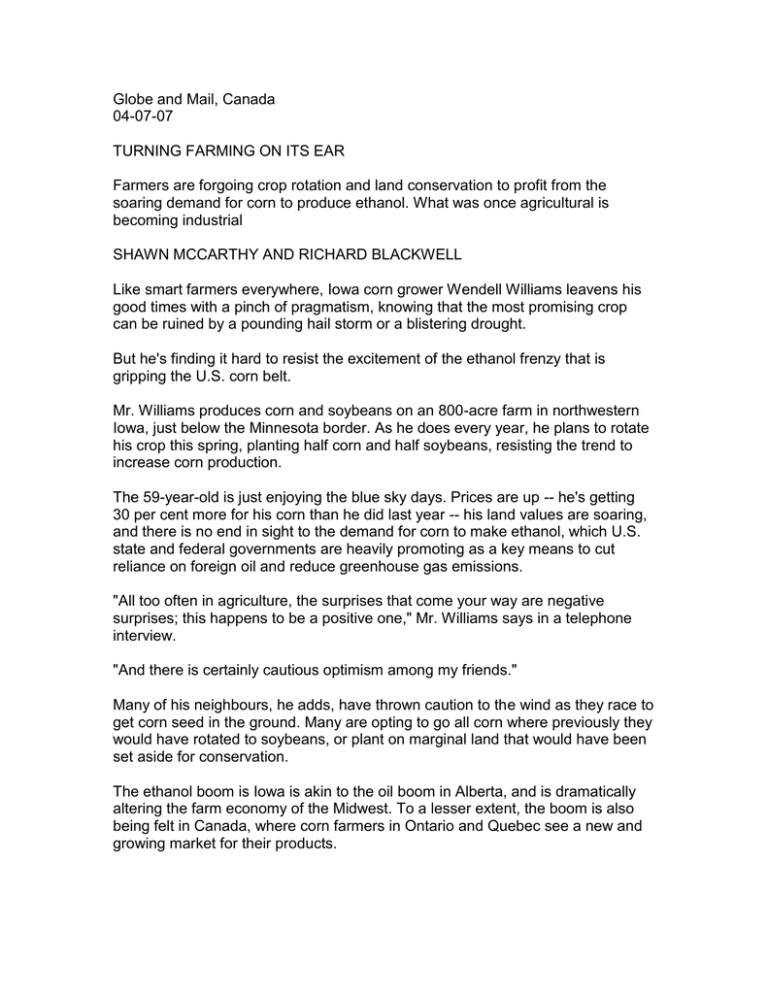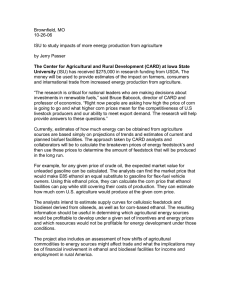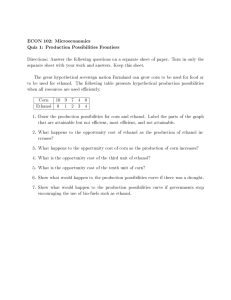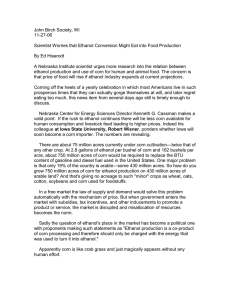Globe and Mail, Canada 04-07-07 TURNING FARMING ON ITS EAR
advertisement

Globe and Mail, Canada 04-07-07 TURNING FARMING ON ITS EAR Farmers are forgoing crop rotation and land conservation to profit from the soaring demand for corn to produce ethanol. What was once agricultural is becoming industrial SHAWN MCCARTHY AND RICHARD BLACKWELL Like smart farmers everywhere, Iowa corn grower Wendell Williams leavens his good times with a pinch of pragmatism, knowing that the most promising crop can be ruined by a pounding hail storm or a blistering drought. But he's finding it hard to resist the excitement of the ethanol frenzy that is gripping the U.S. corn belt. Mr. Williams produces corn and soybeans on an 800-acre farm in northwestern Iowa, just below the Minnesota border. As he does every year, he plans to rotate his crop this spring, planting half corn and half soybeans, resisting the trend to increase corn production. The 59-year-old is just enjoying the blue sky days. Prices are up -- he's getting 30 per cent more for his corn than he did last year -- his land values are soaring, and there is no end in sight to the demand for corn to make ethanol, which U.S. state and federal governments are heavily promoting as a key means to cut reliance on foreign oil and reduce greenhouse gas emissions. "All too often in agriculture, the surprises that come your way are negative surprises; this happens to be a positive one," Mr. Williams says in a telephone interview. "And there is certainly cautious optimism among my friends." Many of his neighbours, he adds, have thrown caution to the wind as they race to get corn seed in the ground. Many are opting to go all corn where previously they would have rotated to soybeans, or plant on marginal land that would have been set aside for conservation. The ethanol boom is Iowa is akin to the oil boom in Alberta, and is dramatically altering the farm economy of the Midwest. To a lesser extent, the boom is also being felt in Canada, where corn farmers in Ontario and Quebec see a new and growing market for their products. In Iowa, plants are sprouting up like corn stalks in a hot summer. Mr. Williams has two ethanol plants within 50 kilometres of his farm, with two more under construction. If all the ethanol plants planned for Iowa are built, they would consume the equivalent of last year's entire corn crop in the state. Like Albertans who see an overheating economy with their oil boom, Iowans worry about the huge increase of trucks on their roads, about the refineries' voracious appetite for water leading to the depletion of ground water, about an influx of out-of-state workers, and about the overall upheaval in their traditional farm economies. Mr. Williams has spent his career selling to the local elevators, which have marketed the corn to poultry farms in Arkansas and pig farms in Oklahoma. With four ethanol plants nearby, he expects he'll sell his crop directly to the fuel producers, as will many of his neighbours. "We're starting to hear some genuine distress from poultry and swine producers," he said. Some are actually cutting back production because feed costs are so high. "This whole ethanol boom has just turned everything on its ear in agriculture," said Mike Duffy, an agricultural economist at Iowa State University. He said the state's agricultural economy is essentially being transformed into an industrial one. "What I liken it to is a giant gong and somebody has whacked the gong with a giant hammer, and it's reverberating and where it's going to end up, we don't know." Egged on by government cheerleaders -- with U.S. President George W. Bush as squad captain -- and supported by generous subsidies, producers from farm coops to multinationals such as Archer-Daniels-Midland Co. are rushing to build more ethanol capacity. Mr. Bush has set a goal of eliminating 75 per cent of oil imports from the Middle East by 2025. Currently, the United States imports almost two million barrels of oil a day from there. The plan calls for increasing U.S. demand for renewable motor fuels to 35 billion gallons by 2017, a fivefold increase from the 2012 renewable standard and 25 per cent of current U.S. gasoline demand. The entire U.S. corn crop could supply ethanol for only 12 per cent of U.S. gasoline demand, or about half of the 35-billion-gallon target. Governments in the United States and Canada are funding the development of cellulosic ethanol, which can be produced from switchgrass, wood chips and other biomass. In Western Canada, ethanol producers use wheat as a feed stock. In 2000, ethanol demand accounted for just 6 per cent of the U.S. corn crop, to produce 1.6 billion gallons. That has risen to 20 per cent of the crop last year, to produce five billion gallons. And most observers expect the industry to meet the 2012 target of 7.5 billion gallons as early as next year, as ethanol producers soak up more than a quarter of the U.S. corn crop. But just as farmers started dreaming of riches, some of the hot air was let out of the corn-ethanol balloon this week. A week ago, the U.S. Department of Agriculture announced that U.S. farmers planned to plant 15 per cent more acres of corn this year than they did in 2006 -the 90.5 million acres of planned planting would be the largest since 1944 when farmers were yielding far fewer bushels per acre. While markets were expecting some increase, the huge jump took traders by surprise and corn prices fell this week. At the Chicago Board of Trade, corn futures had climbed to $4.50 (U.S.) a bushel in early March from $2.60 last fall. After the USDA announcement, futures tumbled to $3.50 before regaining some of that loss, and closed the week at $3.66. Still, a price of $3.50 a bushel is considerably better than the average price of $2.50 over the past several years, when U.S. farmers were relying on generous federal subsidies and taking land out of rotation. Mr. Williams said the price drop should serve as a warning to corn farmers who may be suffering from what former U.S. Federal Reserve chairman Alan Greenspan once termed "irrational exuberance." But he hasn't seen any evidence that the retreat on futures markets has dimmed farmers' enthusiasm to plant as much as they can. "I've been to a lot of meetings where people think the golden goose has landed in our backyard and is going to live there forever and ever and ever, and is going to keep shelling out golden eggs," he said. "And I keep telling people, you know, that goose may be there temporarily. You best pick those eggs up and take very good care of them." He expects a 20-per-cent boost to his income this year as a result of rising prices, but noted that the gains are being eroded by higher costs for land rental, fertilizer and seeds. As well as providing a nice boost to farmers' incomes, the ethanol craze has ignited a boom in land prices in the farm belt. Sam Kain, a broker with Farmers National Bank in West Des Moines, said the increase in corn prices "all tends to get bid back into land prices." He noted that farmers are increasingly reluctant to dedicate land to a federal conservation program, even though they get paid to take their acres out of rotation. "But with current prices, people are not [renewing] some of those contracts," he said. Prof. Duffy does a regular survey of farm land prices in Iowa, and found that they shot up 12 per cent in the second half of 2006. He expects land prices to climb another 15 per cent this year. "I don't see anything over the next three to five years that is going to slow this down," he said. Certainly, the higher corn prices will eliminate some of the more marginal plans for ethanol plants. A typical rule of thumb is that, even with generous subsidies, ethanol producers need corn prices below $4 a bushel and oil prices above $50 a barrel to make production viable. But Ron Lamberty, vice-president of the Renewable Fuels Association, said the producers are adopting modern hedging techniques to protect themselves from sharp increases in corn prices and from a prolonged slump in gasoline prices. As well, the ethanol refineries don't use the entire corn kernel, but only the starch and sugars. They then sell as cattle feed the residual proteins known as distillers dried grain, the value of which rises as corn prices climb. Canada's largest ethanol producer, Toronto-based GreenField Ethanol, said higher corn prices will not deter its expansion plans. GreenField currently operates two plants in Ontario and recently commissioned one in Varennes, Que. It is also building two plants in Ontario. GreenField president Bob Gallant said corn costs represent 60 to 70 per cent of the cost of ethanol production. So the price rise "is clearly painful, there is no doubt about that." But he said his company has successfully hedged its corn costs. Like their U.S. counterparts, Canadian farmers are enjoying the boom in prices, but worry that the frenzy will lead to corn oversupply, which in turn will push down prices. Tom Wilson, who grows corn just south of Sarnia, Ont., knows that just a few months of great weather could result in a bumper crop in North America's corngrowing regions, and if that happens prices will likely tumble despite the ethanol euphoria. This week's retreat could turn into a rout, he worries. "A month ago everything was rosy in the corn world, they were talking of $7 corn," Mr. Wilson said. Now, "anybody who was sitting back waiting for the high price of corn has lost a lot of money." Mr. Wilson has boosted his corn planting -- it's up to about 600 acres from 500 last year -- but that's mainly because conditions for one of his other crops, winter wheat, have not been good. He, like other farmers in the region, stick to a careful rotation of crops, and piling everything into corn just isn't going to happen, even with better prices. Still, higher corn prices have injected some optimism into the Canadian agricultural scene. For one thing, farm real estate is moving again, said Jim Platts, a salesman at O'Rourke Real Estate in Ridgetown, Ont., and that action is clearly linked to rising corn prices. Activity in farm sales is definitely higher this year than in the past two years, Mr. Platts said, but most of the buying is local, "with farmers in the area picking up adjacent land. Properties that have been sitting for a year or so, that needed to be sold for financial reasons, are being picked up." But one factor that keeps Canadian farmers from getting carried away with corn is that, unlike their U.S. counterparts, they won't get subsidies if the price falls. The U.S. corn subsidy program, worth about $9-billion a year in recent years, is being challenged by Canada at the World Trade Organization, but the value of the subsidy is expected to fall as a result of rising prices. Mr. Wilson argues that Ottawa is neglecting farmers and favouring ethanol producers with a support program, announced in last month's budget, that pays 10 cents a litre to ethanol producers. "The Canadian and Ontario governments are heavy on this ethanol bandwagon," he said. "All they want to do is build ethanol plants and get ethanol in cars. Then why don't they pay us to grow corn like they do in the States? To the American farmer, it doesn't bother them at all if the price of corn drops. If the price is low, they'll get their profits out of the government." Ryan Brown, general manager of the Ontario Corn Producers Association, says that if Ottawa isn't careful, its pro-ethanol policy could just mean more U.S. corn is imported for ethanol production, because U.S. subsidies will make it cheaper than what Canada can produce. In the end, farmers such as Mr. Brown aren't doing a lot of complaining about the ethanol-induced corn boom; it's just that they're not expecting to get rich quick. "There's been excellent pricing over the last six months for guys to take advantage of opportunities that haven't been there over the last couple of years," he said. "But keep in mind they're digging out of two to three years of a heck of a hole they've been in." The majority of Canada's corn is planted in Ontario and Quebec, with most of it used for animal feed. National production Ontario: 61% (5.8 million) Quebec: 37% (3.5 million) Rest of Canada: 2% (0.2 million) How it's used in Canada Total use: 10.9 million metric tonnes (Difference from production is made up by imports) Animal feed: 80% (8.7 million) Seed: 0.1% (0.01 million) Human/ industrial: 20% (2.2 million) The ethanol revolution The great debate Does ethanol deliver energy savings and environmental benefits when it is mixed with gasoline? The preponderance of recent studies using a life cycle analysis of the two fuels suggests that it does. The U.S. Department of Energy calculates the full life cycle of ethanol versus gasoline, and concludes that a BTU of ethanol consumes 63 per cent of the fossil energy as a BTU of gasoline. The department reports that, on a per-gallon basis, corn-based ethanol reduces greenhouse gas emissions by 18 to 28 per cent compared with a gallon of gasoline. Skeptics argue that those studies use selective data to achieve a predetermined result. David Pimentel, professor of agriculture and ecology at Cornell University, has calculated that corn-based ethanol requires 29 per cent more fossil energy than the fuel produced. The industry has argued Mr. Pimentel used old data for the calculations. 114 The number of ethanol refineries in the United States. 21.9 billion The number of litres produced there annually. 87 The number of additional plants under construction, or expansion. 8 The number of ethanol refineries in Canada 650 million The number of litres of produced here annually Field of dreams Playing the corn market Both farmers and ethanol producers use hedging techniques to reduce the risk of price swings, primarily by entering into long-term contracts. (At any time, as much as a quarter of Ontario's expected corn crop is presold.) But the tone of the market is set on the Chicago Board of Trade futures market.Commercial traders dominate the CBOT market, buying and selling contracts of 5,000 bushels of corn, based on monthly delivery at a Chicago terminal. But investors -- hedge funds, pension funds and other money managers -- represent a growing presence. One recent entry into the market is the indexed fund, which are increasingly investing in commodity futures to hedge the equity and bond markets. As a result, the volumes of trading in corn futures shot up 67 per cent in the first quarter of this year from the same period last year. How to invest Individual investors looking to jump on the bandwagon have limited options, unless they can tackle the futures markets. The best bet may be to look at public companies with exposure to the corn or ethanol businesses. Agricultural conglomerate Archer-Daniels-Midland Co. is the biggest producer of ethanol in the United States. Several smaller producers are also publicly traded, including VeraSun Energy Corp., Pacific Ethanol Inc. and Aventine Renewable Energy Inc. Monsanto Co. is also a good bet on corn and ethanol, since it is the biggest producer of corn seed in the United States. In Canada, it's harder to directly connect investments with the sector. GreenField Ethanol Inc. has said it plans to go public but hasn't yet done so. Suncor Energy Inc. has an ethanol factory near Sarnia, Ont., but that operation is just a tiny fraction of its overall energy business.







